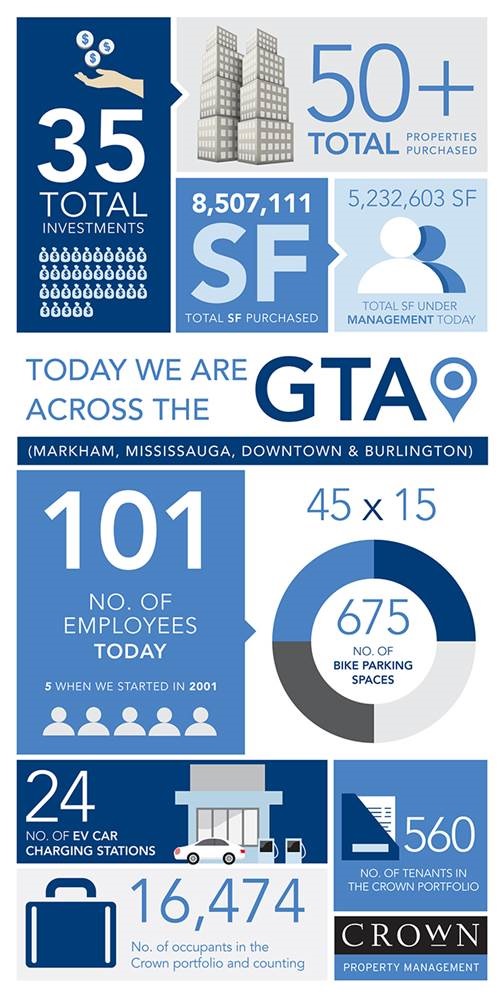Fifteen years ago, the term employee engagement wasn’t on the radar of many commercial office leasing companies, but now, employee considerations play a prominent role in positioning office space to the market, with human resources being a key decision-maker in the process.
Les Miller, managing partner of Crown Realty Partners (Crown), is one industry member who has experienced this transformation. Last month, the real estate company celebrated its fifteen year anniversary and looked back on the changes that have occurred from its launch in 2001 to today.
“The employee now has a voice; the employee is now influencing where companies are locating and what the space will look like,” says Miller. “Companies have moved from a top-down approach to being more concerned about what they can offer employees.”
Scott Watson, partner of leasing and marketing at Crown, says in this “very large war for talent,” companies are seeing their office space as a differentiator to hire those people, whereas fifteen years ago, they didn’t.
He thinks back to a time when the world was afraid of a “work-from-home-mobile-work-force model,” where the idea of telecommuting taking over a demand for office space seemed a plausible outcome.
“Now, you’re seeing a shift of companies wanting people in the office, encouraging casual collisions in the office with different types of meeting spaces,” he says. “This encourages collaboration amongst employees to try to drive future results.”
While larger users are looking for efficiency of space, many smaller offices continue to prefer more traditional layouts that are less open concept.
“I think the private office is going to start to come back into the workforce and you’ll see the footprints get bigger as people go forward and try to attract talent,” notes Watson.
Going forward, he sees companies increasing their square footage per person by adding more amenities to their office space. This includes the suburbs where it is now expected that buildings not be located in the middle of nowhere. Office tenants must provide amenities within the space in order to acquire and retain this top talent.
“People today want vibrant space; they want to feel alive,” says Miller. “If they’re downtown, they want to be next to vibrancy; if they’re in the suburbs, they want vibrancy brought to them.”
Creating Vibrant Space
Recent projects Crown is managing that mirror this trend include 101 McNabb in Markham, Ontario, a 306,710-square foot, three-story office complex that was constructed in 1982 and features fitness centres, onsite food offerings, abundant green space and a shuttle service to the subway station. TD Bank recently moved into this building and re-engineered their workplace to open up collaborative areas, such as a social room for lunch, meetings and workspace. Miller says before the occupancy took place, there were two big design considerations: ensuring there were different ways for staff to interact and energy efficiency, with features like LED lighting installed throughout the space. GM Motors will be moving into the complex soon, with the same intent to create collaborative space with various workstations.
“People want to experience something different from their office building than they used to,” says Watson. “They don’t want to walk in and see a granite lobby; they appreciate differences in design and uniqueness.”
One month ago, the company acquired 2233 Argentia Road in Mississauga, which was purchased on behalf of its fund Crown Realty III Limited Partnership. Located within the Meadowvale Business Park, one of the top suburban office nodes in the GTA, the four-storey, 146,000-square foot office property recently won The Outstanding Building of the Year (TOBY) Award at BOMEX (within the 100,000 – 249,999 square foot category). Major tenants who relocated to this amenity-rich property in the past three years include Brinks, Expedia, Intertek, Regus and SunOpta. Crown says it plans to renovate the building lobby and add new collaborative zones for tenants to work from.
Human Resources is Key
While employee surveys are nothing new, they have evolved since 2001, now gaging employee satisfaction more than issues like benefits and salary. Today, the majority of surveys focus on a company’s culture and values. According to Miller, this more human-centred approach is driving initiatives like Best Managed Companies, for instance.
Creating the best workplaces gives companies an edge in an increasingly competitive business environment. The mindset is no longer about replacing employees, but finding the crème de la crème and retaining this talent to remain successful and grow.
“People started realizing the most important capital was the people they hired and it took a while for our work society to appreciate that,” says Miller.
Human resources now has a strong say as to the type of location a company occupies, while other companies now have more employee ownership and an invested stake in the environment in which they work.
“Companies are not prepared to upset their employee base and move in order to save a dollar per square foot, knowing they will lose employees and need to rehire,” he adds. “They’ve finally figured out that rehiring is a significant cost factor. Now, they will discount the location if they believe they will lose staff. In 2001, I don’t think that came up.”
Future of Office Space
Crown started out with five employees and a desire to collect private capital and make creative investments in real estate for office buildings. After much success and a healthy track record, the now 101-person company has moved into raising institutional funds for capital versus private, and is also looking to add different types of assets to its portfolio.
“When we started the company, we did it with the vision that we’d be a one-stop, full-service organization – meaning that as we have our capital, we would not only be responsible for purchasing the assets and developing the asset plan, but we would also be responsible for the execution. The leasing, construction and tenant services would all be from our one company, a key differentiator for us in the marketplace today” says Miller.
Crown’s customer service approach has helped it adapt to tenant needs in the changing market.
“We are very customer-focused,” says Miller. “We believe the tenant is our customer; we’ve had that philosophy from day one and we haven’t changed that.”
“Listening has been the key to Crown’s success on many investments, adds Watson. “If you listen hard enough, what usually works for one company, works for a lot more, within that same building or portfolio.”
The future for this company looks bright as it plans to close their fourth fund in 2017 and continue a track record of success.











